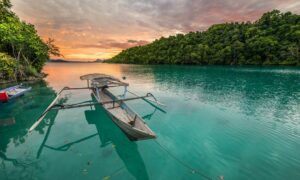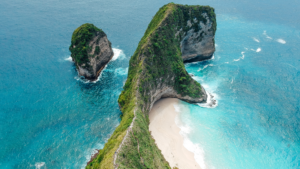Sumba remains one of Indonesia’s best-kept secrets: a place where time moves differently, where ancient traditions persist alongside pristine natural beauty, and where tourists are still a novelty rather than a commodity. Located in Indonesia’s East Nusa Tenggara province, this island of over 850,000 people has successfully resisted the full force of mass tourism, preserving its authentic character and welcoming spirit.
What makes Sumba truly unique begins with its people and culture. The Sumbanese maintain strong indigenous traditions that have survived centuries of external influence. Here, you’ll witness the living practice of hand-weaving ikat textiles an intricate, labor-intensive art form passed down through generations and encounter communities that still build approximately 100 megalithic tombs each year in continuation of ancient burial traditions. The island’s most famous cultural event, the Pasola Festival, is a centuries-old ritual that combines spiritual significance with dramatic spectacle: mounted warriors on horseback engage in traditional spear-throwing ceremonies to celebrate the rice-planting season.
Beyond culture, Sumba offers something increasingly rare in Southeast Asia: genuinely undeveloped beaches and dramatic landscapes. Rather than rows of resorts and water sports operators, you’ll find stretches of pristine coastline, hidden coves with turquoise waters, and white-sand beaches that feel genuinely untouched. The island’s interior features rolling hills, savanna-like plateaus, and limestone formations that create stunning natural scenery, particularly during the dry season when the landscape takes on golden hues.
Sumba is perfect for travelers seeking
- Authentic cultural experiences and village interactions
- Pristine, uncrowded beaches and natural scenery
- Photography opportunities in dramatic landscapes
- An « off-the-beaten-path » adventure in Indonesia
- Slower-paced travel that encourages genuine human connection
- Experience of living traditions and indigenous cultures
HISTORY & CULTURE
The Sumbanese people are the primary indigenous inhabitants of the island, with a complex society comprising 24 different ethnic groups speaking nine Austronesian languages. Despite centuries of outside influence, the Sumbanese have maintained remarkably strong cultural traditions and distinct identity.
TRADITIONAL SPIRITUAL BELIEFS
The island’s spiritual landscape is a fascinating blend of animism, Christianity, and local traditions. Approximately 63% of the island’s population practices Protestantism, 30% Catholicism, with smaller populations following the indigenous Marapu religion—an animistic belief system that emphasizes ancestral veneration and spiritual connection to the land. This religious diversity coexists peacefully, and many Sumbanese blend their Christian faith with traditional beliefs, creating a unique spiritual framework.
The Marapu tradition encompasses deep connections to ancestral spirits, sacred sites, and ritual practices that govern everything from agricultural cycles to life transitions. These beliefs are particularly evident during important ceremonies and the Pasola Festival, where spiritual significance remains paramount even as the event has become more organized for tourist participation.
TRADITIONAL ARCHITECTURE & VILLAGES
Traditional Sumbanese houses are architectural statements in themselves. The characteristic wooden structures feature distinctive steep roofs designed to handle the heavy rains of the monsoon season, and many villages maintain the traditional layout and construction methods passed down through generations. The houses, often built with intricate wooden carvings and natural materials, reflect both practical adaptation to climate and spiritual significance.
Daily life in Sumbanese villages revolves around agriculture, textile production, and community relationships. The rhythm of life follows natural cycles: planting and harvest seasons, weather patterns, and seasonal ceremonies. Villages operate as cooperative communities where extended families share living spaces and resources.
Traditional social structures remain important. Village elders hold authority in community decision-making, dispute resolution, and cultural matters. Respect for elders and family hierarchy are fundamental values that guide behavior and interactions.
Visiting traditional villages provides insight into daily life that remains largely unchanged. You’ll see people engaged in agricultural work, textile production, and community activities. The social structure remains community-oriented, with village elders playing important roles in decision-making and cultural preservation.
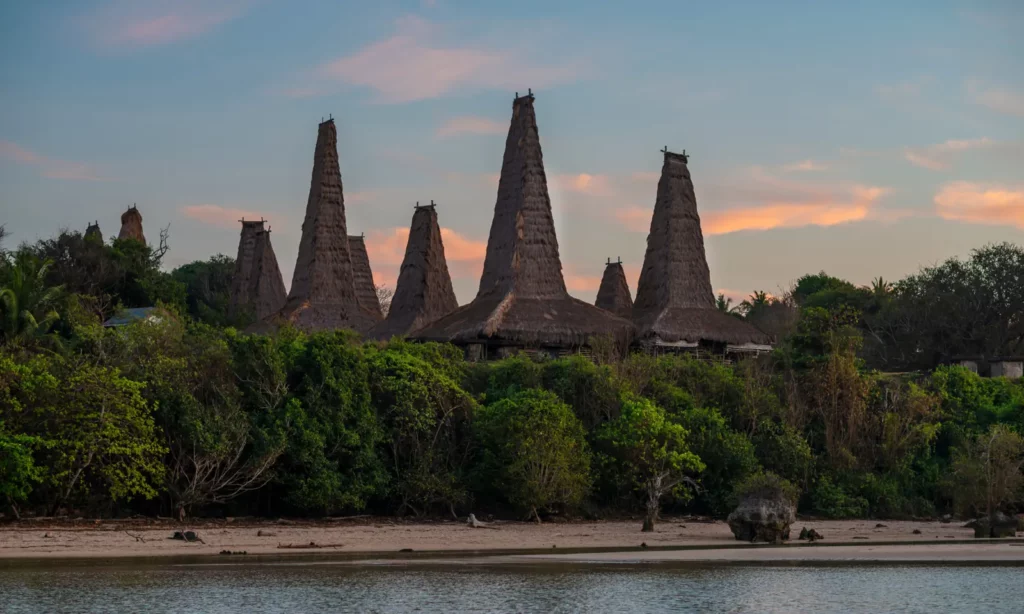
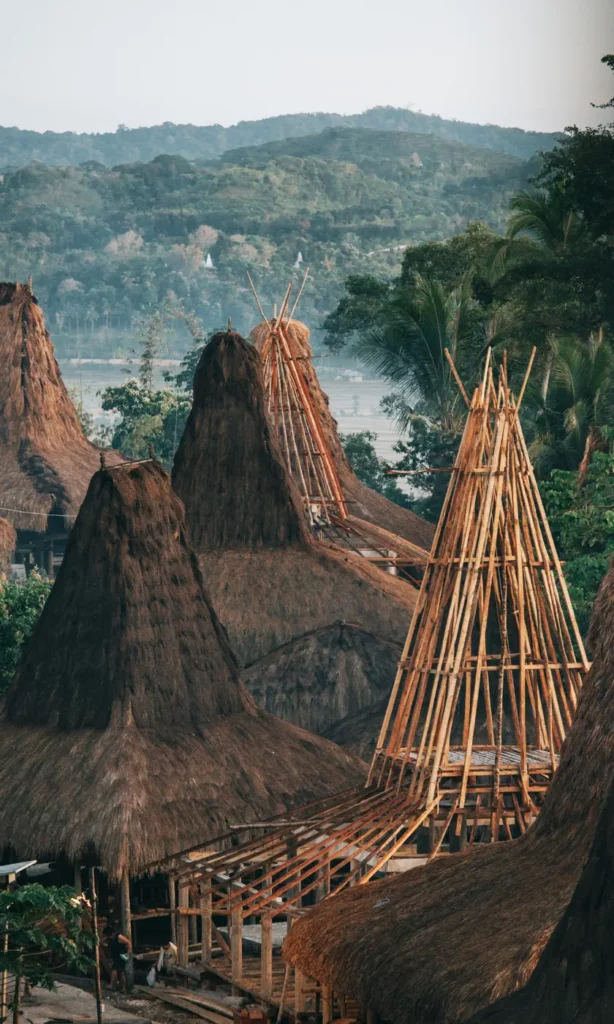
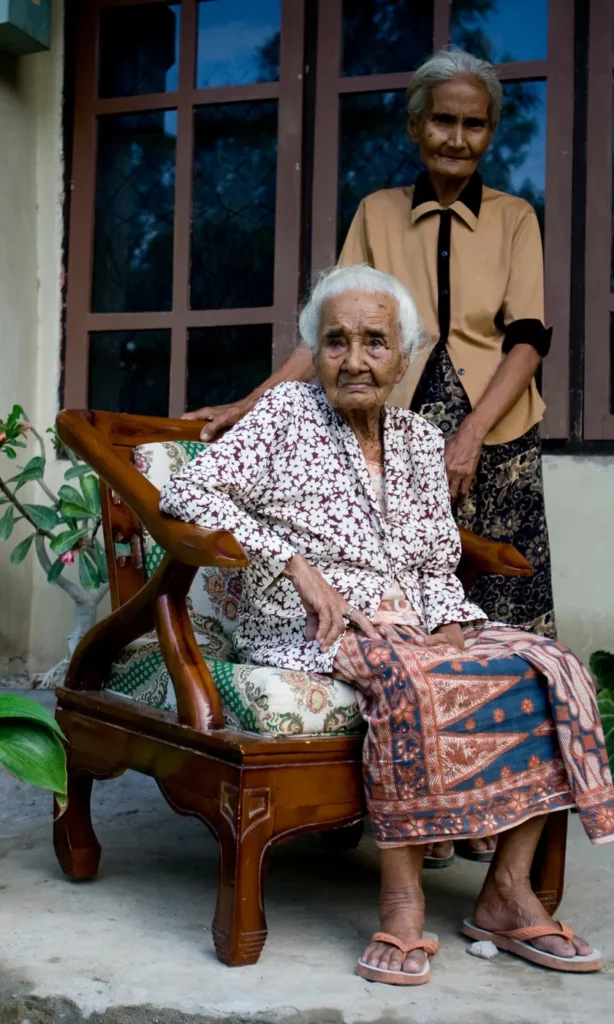
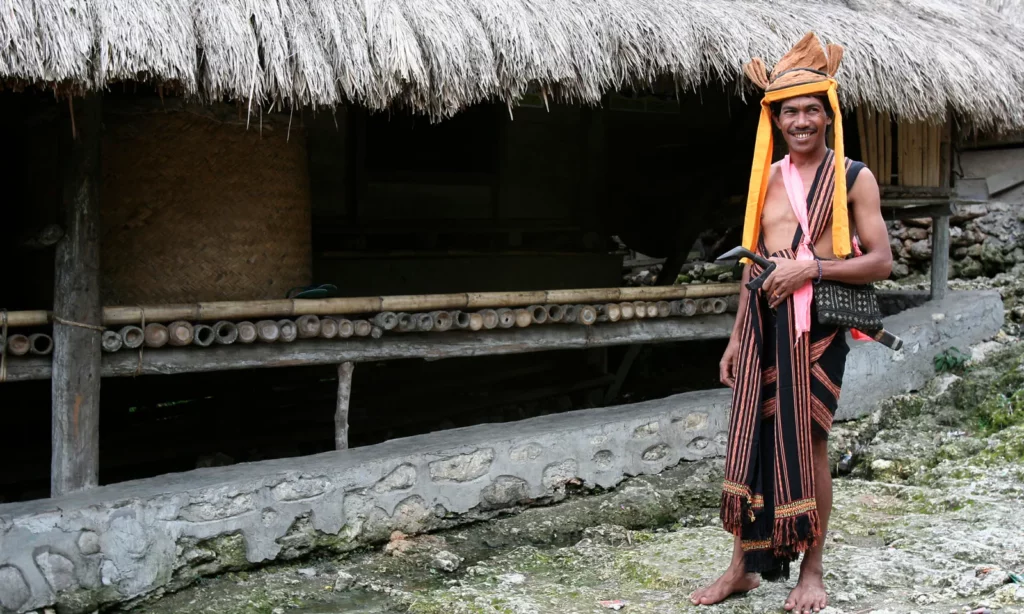
VISITING VILLAGES RESPECTFULLY
When visiting traditional villages, several considerations ensure respectful, positive interactions:
- Ask permission: Always ask before entering villages or taking photographs. Many communities welcome visitors who show genuine interest and respect.
- Hire local guides: Guides from the village or region provide context, facilitate appropriate interactions, and ensure your visit benefits the community economically.
- Understand photography ethics: Some individuals prefer not to be photographed. Always ask before photographing people, particularly children. Consider purchasing photos as a way to compensate people whose images you use.
- Dress appropriately: While tolerance for casual Western dress is common near tourist areas, conservative clothing (covered shoulders and knees) shows respect, particularly when visiting religious sites or ceremonies.
- Learn basic courtesies: Simple greetings and phrases in Indonesian demonstrate respect. « Selamat pagi » (good morning), « terima kasih » (thank you), and « berapa harganya? » (how much?) are useful.
- Avoid disruptive behavior: Loud noise, disrespectful commentary, or intrusive photography disrupts daily life and offends residents.
- Support the economy: Purchase items directly from producers when possible, visit local guides, and choose locally-owned guesthouses.
THE PASOLA FESTIVAL: SUMBA’S MOST SPECTACULAR TRADITION
Pasola is Sumba’s most famous cultural event a mounted spear-fighting competition held annually in February and March. The festival isn’t merely entertainment; it’s a profound spiritual ritual rooted in agricultural cycles and ancestral veneration.
The festival lasts approximately four weeks, with the exact dates traditionally determined by the appearance of sea worms on shore (a natural phenomenon that signals the rice-planting season). While elders now often set dates in advance to accommodate tourists, the connection to natural cycles remains culturally significant.
During Pasola, hundreds of mounted warriors traditionally young men from competing villages engage in ritualized spear-throwing while riding horses. The spears are now blunt, made of wood with metal tips removed, a significant change from historical practices where the ritual could be deadly. Today, injuries occasionally occur, but deaths are rare and considered accidental rather than intentional. The competition serves multiple purposes: it celebrates the rice-planting season, honors ancestors, maintains community bonds through friendly competition, and provides an outlet for youthful energy and skill.
The festival attracts visitors from across Indonesia and abroad, though accommodations in the festival areas book up well in advance. The spectacle of hundreds of horsemen charging across a field, throwing spears with remarkable accuracy while maintaining balance, is genuinely unforgettable. However, participation should be approached with respect for the spiritual and cultural significance underlying the pageantry.
TRADITIONAL CEREMONIES
Beyond Pasola, the Sumbanese calendar includes numerous traditional ceremonies marking life transitions and seasonal changes. Funeral ceremonies are particularly significant elaborate multi-day events where families gather to honor the deceased and ensure proper spiritual transition. These ceremonies often involve animal sacrifice (water buffalo or pigs), feasting, and ritual activities. While some villages welcome respectful observation by visitors, it’s essential to seek permission and guidance from local guides familiar with appropriate etiquette.
Wedding ceremonies, birth celebrations, and seasonal agricultural rituals also punctuate the calendar. These ceremonies often involve communal participation, making them valuable opportunities for cultural understanding provided visitors approach with genuine respect rather than mere curiosity.
HISTORICAL BACKGROUND
Sumba’s history spans thousands of years. Archaeological evidence, including the Lambanapu site near Waingapu, shows human habitation dating back approximately 2,800 years. Ancient megalithic burial practices suggest sophisticated social organization and spiritual beliefs developed over millennia.
The Portuguese arrived in the Indonesian archipelago in 1522, though their direct influence on Sumba was limited. By around 1600, Dutch colonizers established control, and Sumba became part of the Dutch East Indies. During the colonial period, the island became known as « Sandalwood Island » due to the valuable sandalwood trade, which drove significant economic activity and, unfortunately, environmental degradation through overexploitation.
Following Indonesian independence in 1945, Sumba became part of East Nusa Tenggara province. The island remained relatively isolated from Indonesia’s rapid modernization, which paradoxically preserved its cultural traditions while limiting economic development. Today, Sumba is gradually opening to tourism, but its infrastructure remains relatively underdeveloped compared to other Indonesian destinations—a situation that many travelers see as a feature rather than a flaw.
IKAT WEAVING & TEXTILES
Sumba’s hand-woven ikat textiles are among Indonesia’s most prized. Ikat is a resist-dyeing technique where threads are tied in patterns before dyeing, creating intricate designs of remarkable beauty and complexity.
The process is extraordinarily labor-intensive. Artisans begin by creating patterns through careful tying of threads, then dye the bundles in multiple rounds to build colors and designs. The resulting textiles feature characteristic slightly blurred patterns—a feature collectors prize as evidence of authentic hand-production. A single ikat cloth can take weeks or months to complete, depending on complexity.
Regional variations in Sumba’s ikat production create distinctive styles. Different areas have developed characteristic color palettes and design traditions, passed down through families. Many weavers are women, and textile production remains an important part of the household economy and cultural identity.
When visiting Sumba, opportunities to see weavers at work in homes and small workshops provide direct insight into this art form. Many weavers welcome respectful visitors and sell directly, allowing you to purchase authentic textiles at fair prices while directly supporting artisans. However, prices in tourist-oriented shops can be significantly inflated, so seeking recommendations for ethical, fair-trade sources is important.



GEOGRAPHY, CLIMATE & LANDSCAPE
Geographic Overview
Sumba is one of Indonesia’s larger islands, covering 11,243 square kilometers (approximately the size of Jamaica) in the Lesser Sunda Islands of East Nusa Tenggara province. It sits northwest of Timor and northeast of Sumbawa, separated from neighboring islands by the Sumba Strait.
Rather than the volcanic peaks characteristic of much of Indonesia, Sumba features low limestone hills and plateaus. This geological difference creates distinctive landscape instead of steep mountainous terrain, the island offers rolling hills, savanna-like plains (particularly in the eastern regions), and limestone formations that create dramatic scenery, especially at sunset.
The island’s topography varies significantly between regions. The western region is more fertile and densely populated, while the arid north and east feature more sparse vegetation and lower population density. This geographic variation means different regions offer distinctly different experiences and landscapes.
Climate & Seasons
Sumba’s climate follows two distinct seasons, dramatically affecting landscape appearance, road accessibility, and activity suitability.
DRY SEASON (MAY TO NOVEMBER)
The dry season is unquestionably the best time to visit. During these months, temperatures remain warm (typically 25-30°C or 77-86°F) with minimal rainfall. Clear skies provide exceptional visibility for photography, and the landscape takes on golden, sun-bleached tones as vegetation dries.
The dry season is ideal for:
- Beach visits and water activities
- Trekking and hiking
- Photography
- Cultural activities and ceremonies
- Travel throughout the island
Roads are generally passable during the dry season, though some remote areas may still present challenges. This is peak tourism season, meaning prices are higher and accommodations book faster, though Sumba remains far less crowded than other Indonesian destinations.
WET SEASON (DECEMBER TO MARCH)
The wet season brings significant rainfall, particularly in January and February, with temperatures remaining warm (26-31°C or 79-88°F). Rather than continuous rain, rainfall is typically concentrated in afternoon downpours, with mornings often remaining clear.
The wet season transforms the landscape into lush green—a striking contrast to the dry season’s golden tones. The island’s natural beauty takes on different character, with vibrant vegetation and dramatic cloud formations creating exceptional photography opportunities for those who appreciate moody, textured landscapes.
The wet season presents some challenges
- Roads, particularly in remote areas, can become muddy and impassable
- Some accommodations close or operate with reduced services
- Pasola Festival occurs in February/March (exact dates vary annually), so accommodations in festival areas are nearly impossible to find during this window
- Fewer tourists means smaller crowds and better prices
However, the wet season appeals to adventurous travelers seeking lower prices, fewer crowds, and a genuinely different experience of the island.
Natural Landscapes & Features
BEACHES AND COASTAL AREAS
Sumba’s coastline stretches across dramatic and varied terrain. The island features:
- White and pink sand beaches: Some beaches feature unusual pink-tinted sand created by coral and shell fragments, creating striking visual contrasts with turquoise water.
- Pristine swimming beaches: Several easily accessible beaches offer safe swimming conditions and beautiful scenery.
- Rocky coves and formations: Dramatic limestone cliffs and rocky outcrops create photogenic landscapes, particularly in southern regions.
- Relatively uncrowded shores: Unlike major tourist destinations, most Sumbanese beaches see few visitors, preserving their pristine character.
The beaches vary significantly in accessibility, some require substantial travel over rough roads, while others are relatively close to main towns. This variation means beaches range from easily accessible tourism-oriented areas to genuinely remote, undeveloped shores.
INTERIOR LANDSCAPES
Beyond the coast, Sumba’s interior offers diverse landscapes:
- Savanna-like plateaus: Particularly in eastern regions, open grassland areas create African-like scenery rare in Indonesia.
- Rolling hills and valleys: Forested and agricultural areas feature beautiful undulating terrain.
- Agricultural landscapes: Rice paddies and traditional farming areas showcase daily life and seasonal transformations.
- Scenic viewpoints: Several high-elevation areas provide panoramic views across the island and toward neighboring islands.
WILDLIFE AND NATURAL ENVIRONMENT
Sumba’s fauna includes several notable species. The Sumbese deer, endemic to the island, can occasionally be spotted in suitable habitats. Bird watching opportunities abound, with numerous endemic and migratory species. However, deforestation and habitat loss have impacted wildlife populations, making sightings less common than in less-developed periods.
The island’s flora reflects both its tropical climate and significant deforestation. Traditional agriculture: rice paddies, coconut plantations, and subsistence farming covers much of the island. Some remaining native forests harbor endemic plant species, though extensive historical sandalwood harvesting and modern deforestation have significantly reduced forest coverage.




REGIONS OF SUMBA
Sumba’s different regions offer distinctly different experiences and attractions.
WEST SUMBA
West Sumba is the more fertile and densely populated region, with better infrastructure and more tourism development. The main city of Waikabubak serves as the regional hub, though it remains small by Indonesian standards. West Sumba concentrates most of Sumba’s cultural attractions, including several traditional villages and the primary Pasola Festival locations. The region offers easier accessibility but slightly less « remote » atmosphere compared to eastern areas.
Best for: Cultural immersion, traditional villages, Pasola Festival attendance, travelers preferring slightly easier logistics
EAST SUMBA
East Sumba is more arid and less densely populated, with a savanna-like landscape distinct from the wetter west. Waingapu, the largest city on the island with about 73,000 residents, is the main hub and home to the primary airport (also called Waingapu). The region features beautiful beaches and dramatic landscapes, with less tourism infrastructure than the west.
Best for: Beach lovers, photographers, adventure travelers, those seeking remoteness and fewer crowds
SOUTH/SOUTHWEST SUMBA
The southern coast features Sumba’s most dramatic coastal scenery, with limestone cliffs, remote beaches, and less infrastructure. This region requires more effort to access but rewards travelers with genuinely undeveloped beaches and spectacular natural scenery.
Best for: Adventure travelers, photography enthusiasts, those seeking remoteness and unique natural beauty
CENTRAL/RURAL SUMBA
The interior regions offer traditional village experiences, trekking opportunities, and agricultural landscapes. These areas are most remote but provide deepest cultural immersion for those willing to make extra effort.
Best for: Cultural immersion, trekking, adventure travelers, photographers seeking authentic experiences
THINGS TO DO & SEE
Beaches
Sumba’s beaches range from easily accessible tourism-friendly areas to genuinely remote, undeveloped shores. Here are the highlights:
TANGSI BEACH (EAST SUMBA)
One of Sumba’s most beautiful and accessible beaches, Tangsi features pristine white sand, clear turquoise water, and dramatic limestone cliff backdrops. The beach is relatively undeveloped, with basic warungs (small restaurants) providing refreshments. It’s ideal for swimming, snorkeling, and sunset photography. Location: Near Waingapu, approximately 30km drive.
PINK BEACH (SOUTHWEST SUMBA)
Named for its distinctive pinkish sand created by coral and shell fragments, Pink Beach is one of Indonesia’s most visually striking beaches. The unusual coloring creates a magical atmosphere, particularly at sunset. The beach is more remote than Tangsi, requiring travel over rougher roads, but rewards visitors with a genuinely unique experience. Swimming and photography are the primary activities.
MELOLO BEACH (EAST SUMBA)
Located near Melolo village, this beach offers calm waters suitable for swimming and snorkeling. It’s more developed than some alternatives, with local restaurants and basic facilities. The surrounding fishing village provides cultural context, and early morning visits allow observation of fishermen heading out.
RUA BEACH (WEST SUMBA)
One of Sumba’s longest beaches, Rua offers broad stretches of sand and excellent conditions for long walks and exploration. The beach is less crowded than more accessible alternatives, particularly outside the main tourism season. It’s ideal for those seeking solitude and natural beauty.
PANTAI MAROSI (WEST SUMBA)
This lesser-known beach features dramatic scenery with limestone formations creating natural sculptures. The relatively undeveloped conditions appeal to adventure travelers seeking genuine remoteness.




Villages & Cultural Experiences
Several villages offer genuine opportunities to experience traditional Sumbanese life:
PRAIJING VILLAGE (WEST SUMBA)
Known for preserved traditional architecture and ikat weaving, Praijing is one of Sumba’s most culturally intact villages. Traditional houses with characteristic steep roofs create a living museum of architecture. Many residents practice traditional weaving, offering opportunities to observe the intricate process. Photography is generally welcome with permission.
RENDE VILLAGE (EAST SUMBA)
This traditional village maintains strong cultural practices and distinctive wooden architecture. The village is somewhat less visited than Praijing, offering more authentic interactions with residents. Local guides from the village provide excellent context and facilitate appropriate interactions.
KODI VILLAGES (WEST SUMBA)
The Kodi region comprises several villages known for strong cultural preservation and impressive megalithic sites. This area is more remote and requires more effort to access, but rewards visitors with deeper cultural immersion and fewer tourists.
Natural Attractions & Outdoor Activities
HIKING & TREKKING
Sumba’s landscape offers numerous trekking opportunities:
- Gentle walks: Short village walks and easy day trips suitable for most fitness levels
- Day hikes: Full-day hiking adventures to viewpoints, natural formations, or through agricultural landscapes
- Multi-day treks: Extended trekking combining village experiences, natural scenery, and cultural immersion
Trekking conditions vary by season. The dry season offers stable weather and good trail conditions, while the wet season can make trails muddy and challenging. Most treks work best with experienced local guides who navigate terrain, facilitate village interactions, and provide cultural context.
WATER ACTIVITIES
Beyond swimming and snorkeling, Sumba offers:
- Snorkeling: Reasonably good snorkeling in selected beaches, though not as dramatic as diving-focused destinations
- Surfing: Sumba offers remote, consistent surf breaks during the dry season (April-October). Top spots like Occy’s Left and Miller’s Right attract experienced surfers, though strong currents and sharp reefs demand respect. Beginners should try Tarimbang Beach, which features milder, more forgiving waves.
- Boat tours: Local boatmen can arrange beach-hopping trips or sunset cruises
- Traditional fishing village visits: Observing daily fishing practices and traditional boats
WILDLIFE WATCHING
Bird watching presents the best wildlife observation opportunity, with numerous endemic and migratory species. Early morning walks through agricultural and forested areas increase sighting chances. Local guides familiar with bird identification enhance the experience.
Festivals & Seasonal Events
PASOLA FESTIVAL (FEBRUARY TO MARCH)
The four-week Pasola Festival remains Sumba’s most significant event and major draw for cultural tourists. The festival features:
- Mounted spear-throwing ceremonies: Hundreds of warriors on horseback engaging in ritualized spear-throwing
- Multiple competition locations: Different villages host events on different dates
- Festival atmosphere: Crowds, celebrations, food vendors, and festive environment
- Spiritual significance: The underlying connection to agricultural cycles and ancestor veneration
Attending Pasola requires advance booking of accommodations (sometimes months in advance), hiring experienced guides familiar with the festival’s different locations and etiquette, and understanding that the experience combines genuine cultural significance with tourist spectacle.
OTHER SEASONAL EVENTS
While less internationally famous than Pasola, other seasonal celebrations include:
- Religious observances: Christian holidays celebrated throughout the island
- Community ceremonies: Life transition ceremonies (marriages, funerals) occasionally open to respectful visitors
- Agricultural season celebrations: Seasonal festivities connected to planting and harvest
Getting to Sumba
Sumba has two airports serving commercial flights:
1. Waingapu Airport (Hardjo Kusumo International Airport) – East Sumba
- The larger airport with more frequent flights
- Serves as the primary international gateway
- Direct flights from Bali are the most common route (approximately 2 hours)
2. Tambolaka Airport (Tanjung Batu Airport) – West Sumba
- Smaller airport with fewer flights
- Useful for accessing West Sumba directly
Most international travelers fly through Bali’s Ngurah Rai International Airport, then take domestic flights to Sumba. This routing offers multiple airline options like Garuda and Lion Air.
Ready to Discover Sumba?
Sumba offers an authentic Indonesian experience that grows rarer each year: pristine beaches, living cultural traditions, warm hospitality, and the freedom from mass tourism that characterizes more developed destinations. Whether you’re seeking cultural immersion, natural beauty, photography opportunities, or simply a different kind of travel experience, Sumba rewards the extra effort required to reach it.
PLAN YOUR SUMBA TRIP
We can help you create a customized Sumba experience tailored to your interests, budget, and travel style. Just fill in the form on this page or tell us a bit more about your project and our travel experts will get back to you for a personalized adventure planning.
Frequently Asked Questions
How do I get to Sumba?
The most common route is flying to Bali (Indonesia’s main international hub), then taking a domestic flight to Waingapu (2 hours) or occasionally Tambolaka. Garuda Indonesia, Lion Air, and other carriers operate these routes. The entire journey from most international origins takes 20-30+ hours including connections and airport time.
How long should I stay in Sumba?
This depends on your interests. Minimum recommended stay is 4-5 days for a basic overview of beaches and one or two cultural experiences. For meaningful cultural immersion and varied experiences, 7-10 days is ideal. Two weeks allows deeper exploration of multiple regions and more authentic village interactions. Staying less than 4 days limits time for travel between areas (roads require more time than in more developed destinations).
When is the best time to visit?
May-November (dry season) is best for most travelers. Within this period, June-September offers peak conditions while September-October provides good conditions with fewer tourists and lower prices. The wet season (December-March) is viable for adventurous travelers seeking lower prices and fewer crowds, though weather is less predictable.
Do I need a guide?
Guides are optional but highly recommended. Experienced guides provide cultural context, facilitate village interactions, navigate logistics, and ensure your visit economically benefits local communities. Many travelers successfully navigate independently, but guides enhance the experience significantly and are nearly essential for meaningful village experiences.
Is English widely spoken?
English is spoken in hotels, main towns, and by professional guides, but is not widely understood in villages or rural areas. Learning basic Indonesian phrases (greeting, thank you, common questions) is helpful and appreciated. Many Sumbanese speak Indonesian in addition to local languages, which provides a common language with guides and local business owners.
What’s the transportation like?
Roads vary in quality: main routes between towns are generally passable but slower than developed country standards. Travel between areas takes more time than expected; what appears geographically close may require 2-3 hours of driving. Public minibuses (bemos) exist for local travel but operate on irregular schedules.
Is it okay to take photos of people/villages?
Always ask permission before photographing individuals, particularly children. Many people enjoy being photographed and may request copies. When photographing villages, seek permission from community leaders or guides. Photography in spiritual ceremonies requires explicit approval. Respecting « no » answers and not being intrusive ensures positive interactions.
What’s appropriate clothing?
Casual, comfortable clothing suitable for tropical climate is fine for beaches and towns. For villages and cultural sites, conservative dress (covered shoulders and knees) shows respect. Swimwear is appropriate at beaches. Lightweight, breathable fabrics are most comfortable. Religious sites require covered shoulders and knees.
Is Sumba safe for tourists?
Yes, Sumba is generally very safe for tourists. Crime against visitors is rare, and the culture emphasizes hospitality. Normal travel precautions apply: avoid displaying expensive items, maintain awareness of surroundings, and use common sense. Woman solo travelers generally report positive experiences, though the same precautions applicable anywhere remain advisable.
Is it safe for women traveling alone?
Many solo female travelers visit Sumba without incident and report positive experiences. Standard precautions applicable to solo female travel anywhere remain advisable. Dress conservatively, maintain awareness, and avoid isolated situations. The culture’s general hospitality and low crime against tourists make it relatively safe compared to many destinations. Connecting with other travelers and hiring reputable guides provides additional security.


